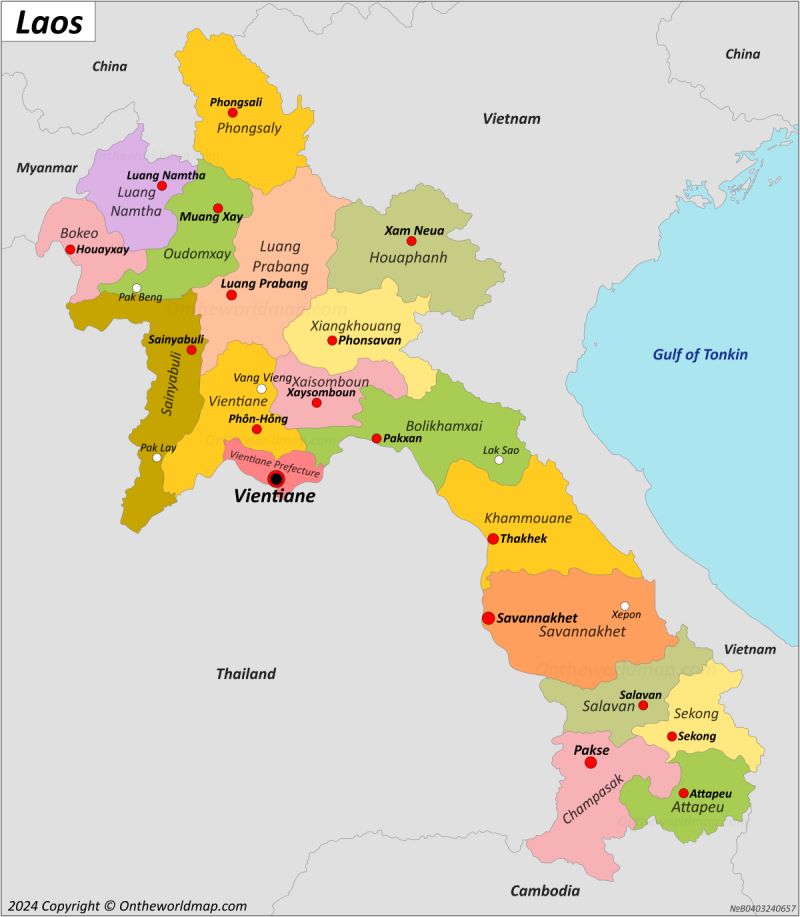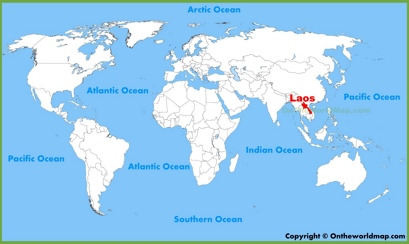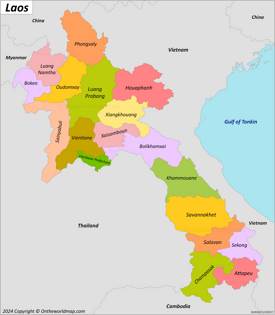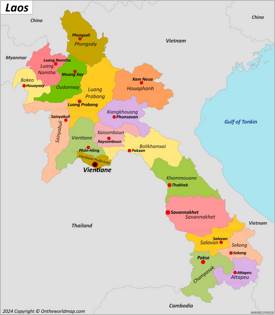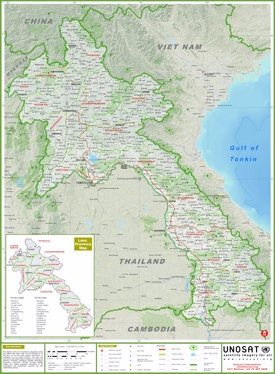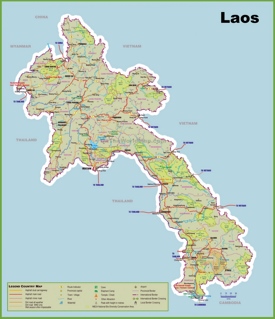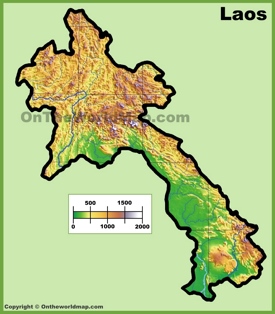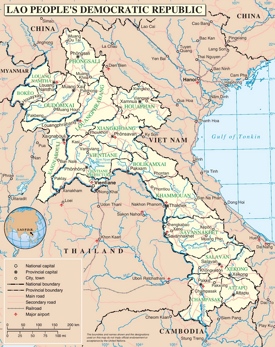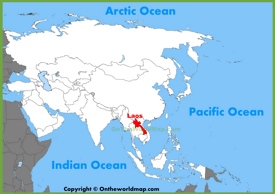Laos Map
Description:
This map shows governmental boundaries of countries; provinces, province capital cities, and major cities and towns in Laos.
Size: 900x1406px / 304 Kb
Author: Ontheworldmap.com
You may download, print or use the above map for educational, personal and non-commercial purposes. Attribution is required. For any website, blog, scientific research or e-book, you must place a hyperlink (to this page) with an attribution next to the image used.
Online Map of Laos
Detailed Maps of Laos
About Laos
Laos, officially known as the Lao People's Democratic Republic, occupies a central part of the Southeast Asian peninsula. It shares borders with five countries: China to the north, Vietnam to the east, Cambodia to the south, Thailand to the west, and Myanmar to the northwest. Unlike many of its neighbors, Laos it as a landlocked country. The Mekong River plays a big part in the region's economy and society and boerders mainly with Thailand.
The geographical landscape of Laos features a predominantly mountainous terrain, with some plains and plateaus. The Annamite Range in the east and the Luang Prabang Range in the north contribute to the country's rugged topography. Its climate, tropical and monsoonal, supports diverse ecosystems and rich biodiversity, particularly in areas like the Bolaven Plateau and the Nam Ha National Biodiversity Conservation Area.
Vientiane, the capital, lies on the banks of the Mekong River near the Thai border. It serves as the country's economic, cultural, and political hub. Other significant cities include Luang Prabang, renowned for its Buddhist temples and colonial architecture, and Savannakhet, which plays a vital role in regional trade due to its proximity to Thailand and Vietnam.
Tourism in Laos has grown substantially, reflecting the country's rich cultural heritage and natural beauty. Key attractions include the ancient city of Luang Prabang, designated a UNESCO World Heritage Site for its historic temples and French colonial architecture. The Plain of Jars, a mysterious archaeological site in Xieng Khouang Province, draws considerable interest for its thousands of stone jars scattered across the landscape. Vang Vieng, once known for its backpacker-oriented nightlife, now attracts tourists for its outdoor activities like caving, rock climbing, and river tubing.
Laos also boasts significant religious and natural sites, such as the Pak Ou Caves with its thousands of miniature Buddha statues, and the Si Phan Don (Four Thousand Islands) in the Mekong River, where tourists can spot the rare Irrawaddy dolphins. Moreover, the Bolaven Plateau is famous for its waterfalls, ethnic villages, and coffee plantations.
In conclusion, Laos, with its blend of cultural heritage, natural landscapes, and religious sites, continues to evolve as a key destination in Southeast Asia for travelers seeking both adventure and tranquility.
The Facts:| Flag: |
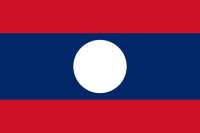
|
| Capital: | Vientiane |
| Area: | 91,400 sq mi (236,800 sq km) |
| Population: | ~ 7,800,000 (2023 estimate) |
| Official language: | Lao |
| Religion: |
|
| Ethnic groups: |
|
| Currency: | Kip (₭) (LAK) |
| Driving side: | right |
| Calling code: | +856 |
| Internet TLD: | .la |
| Time zone: | UTC+7 (ICT) |
| Gross domestic product (PPP): |
|
| Gross domestic product (nominal): |
|
| Official tourism website: | www.tourismlaos.org |
Google Map of Laos
List of Largest Cities in Laos
- Vientiane (1,000,000)
- Savannakhet (130,000)
- Pakxe (125,000)
- Thakhek (90,000)
- Luang Prabang (60,000)
- Xam Neua (50,000)
- Phonsavan (40,000)
- Muang Pakxan (30,000)
- Vang Vieng (28,000)
- Muang Xai (27,000)
- Xaysomboun (26,000)
- Attapeu (22,000)
- Houayxay (20,000)
- Luang Namtha (19,000)
- Sainyabuli (17,000)
Main sights in Laos
- Vat Phou
- Kuang Si Falls
- Kong Lor Caves
- Khone Phapheng Falls
- Temples in Luang Prabang
- Nong Khiaw
- Tham Phu Kham
- Patuxai
- Pha That Luang
- Haw Phra Kaew
- Pha Tad Ke Botanical Garden
- Wat Si Saket
- Wat Ong Teu Mahawihan
- Buddha Park
- Wat Xieng Thong
Provinces of Laos
| Province | Capital | Area | Population |
|---|---|---|---|
| Attapeu | Attapeu | 3,985 sq mi (10,320 sq km) | 120,000 |
| Bokeo | Houayxay | 2,392 sq mi (6,196 sq km) | 160,000 |
| Bolikhamsai | Paksan | 5,739 sq mi (14,863 sq km) | 225,000 |
| Champasak | Pakse | 5,952 sq mi (15,415 sq km) | 590,000 |
| Houaphanh | Xam Neua | 6,371 sq mi (16,500 sq km) | 330,000 |
| Khammouane | Thakhek | 6,299 sq mi (16,315 sq km) | 365,000 |
| Luang Namtha | Luang Namtha | 3,600 sq mi (9,325 sq km) | 155,000 |
| Luang Prabang | Luang Prabang | 6,515 sq mi (16,875 sq km) | 420,000 |
| Oudomxay | Muang Xay | 5,934 sq mi (15,370 sq km) | 285,000 |
| Phongsaly | Phongsali | 6,282 sq mi (16,270 sq km) | 205,000 |
| Sainyabuli | Sayabouly | 6,328 sq mi (16,389 sq km) | 395,000 |
| Salavan | Salavan | 4,128 sq mi (10,691 sq km) | 350,000 |
| Savannakhet | Savannakhet | 8,407 sq mi (21,774 sq km) | 750,000 |
| Sekong | Sekong | 2,959 sq mi (7,665 sq km) | 85,000 |
| Vientiane Prefecture | Vientiane | 1,514 sq mi (3,920 sq km) | 1,100,000 |
| Vientiane Province | Phonhong | 6,149 sq mi (15,927 sq km) | 390,000 |
| Xiengkhouang | Phonsavan | 6,131 sq mi (15,880 sq km) | 235,000 |
| Xaisomboun | Anouvong | 3,205 sq mi (8,300 sq km) | 85,000 |
Geography of Laos
Laos, a landlocked country in Southeast Asia, has a total area of approximately 236,800 square kilometers. Its terrain is characterized by rugged mountains in the north, including the Annamite Mountain Range, which also extends into Vietnam, and plateaus and fertile plains in the south. The Mekong River, a prominent feature of Laos, runs along the western border and serves as a major transportation route and a vital source of water for agriculture.
The country has a tropical monsoon climate, featuring distinct wet and dry seasons, with high humidity and rainfall. Laos is rich in biodiversity, with dense forests covering a significant portion of its land, and the country is known for its natural beauty and ecotourism opportunities.
Major Rivers of Laos
- Mekong River
- Nam Ngum River
- Sông Xê Pôn River
- Nam Ou River
- Nam Khan River
- Xe Bangfai River
- Nam Song River
- Banghiang River
- Ma River
- Cả River River
- Nam Hinboun River
- Nam Theun River
- Nam Xan River
- Hueang River
- Nam Tha River
Mountains of Laos
- Phou Bia (2,819m)
- Phu Xai Lai Leng (2,720m)
- Phou Tong Chinh (2,355m)
- Rào Cỏ Mountain (2,286m)
- Phu Soi Dao (2,120m)
- Phou Khe (2,079m)
- Shiceng Dashan (1,830m)
- Phou Pha Thi (1,786m)
- Doi Phi Pan Nam (1,745m)
- Phu Chi Fa (1,442m)
- Dong Ap Bia (937m)
Brief History of Laos
Laos has a complex history characterized by various kingdoms and dynasties. The region that is now Laos was initially inhabited by tribal groups before the establishment of the ancient kingdom of Lan Xang in the 14th century. Lan Xang, meaning "Million Elephants," was founded by King Fa Ngum and became a powerful state that controlled much of present-day Laos and parts of neighboring territories.
During the 19th and early 20th centuries, Laos came under French colonial rule as part of French Indochina, alongside Vietnam and Cambodia. The French established administrative control, introducing Western education and institutions. Laos gained independence from France in 1954 following the First Indochina War, but political instability and conflicts persisted.
The Vietnam War had a significant impact on Laos, as the country became embroiled in the conflict due to its strategic location. Laos experienced heavy bombing by the United States during the war, affecting its infrastructure and economy. The Pathet Lao, a communist group, gained control of Laos in 1975, establishing a single-party state that continues to govern the country to this day.
Last Updated: March 26, 2024

